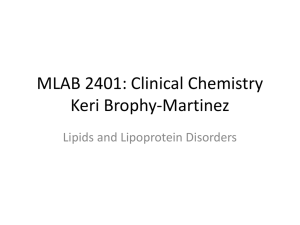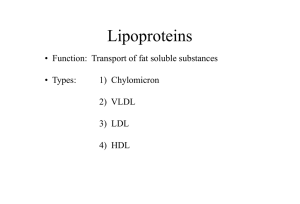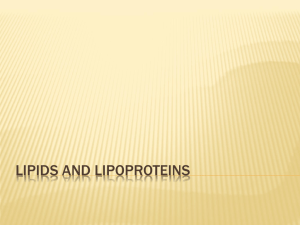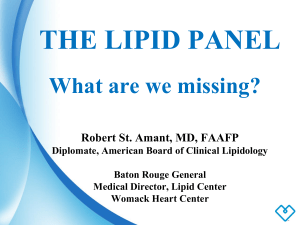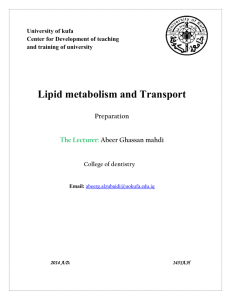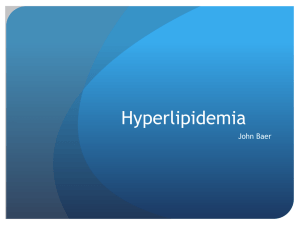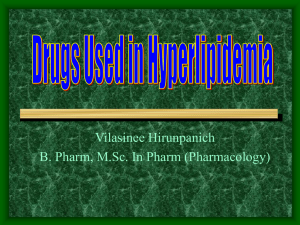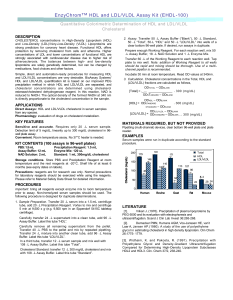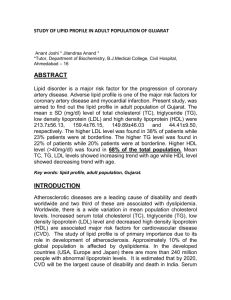File
advertisement
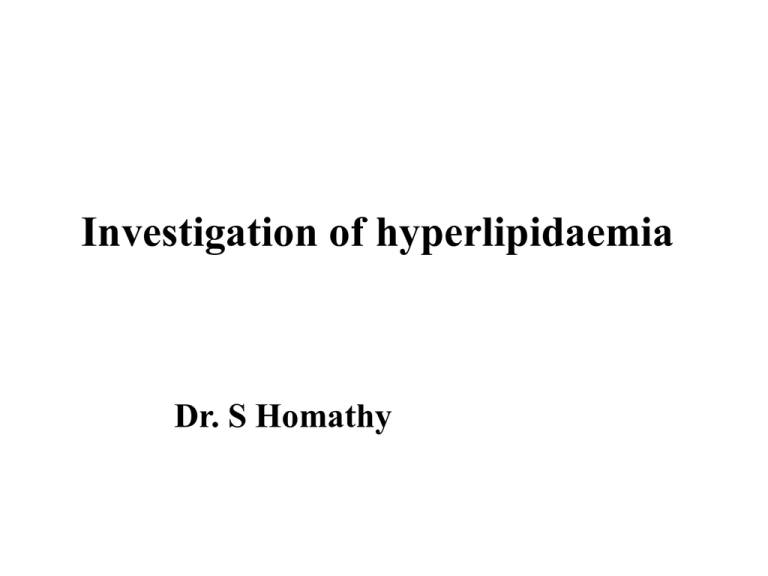
Investigation of hyperlipidaemia Dr. S Homathy Properties of lipids • • • • Hydrophobic High-energy food For cell membranes, steroid hormones Some lipids essentially exogenous Lipo-protein structure • Fat globule in water • Central hydrophobic core Triglycerides Esterified cholesterol • Outer shell Apoproteins Phospholipids Non-esterified cholesterol Types of lipo-proteins • • • • • High density (HDL) Low density (LDL) Very low density (VLDL) Intermediate density (IDL) Chylomicrons Primary Functions • • • • • HDL -Cholesterol from tissue to liver LDL -Cholesterol to tissue VLDL -Endogenous triglycerides IDL -Transient form Chylomicron -Exogenous triglycerides Broad basedly … • HDL = GOOD Cholesterol • LDL = BAD Cholesterol Composition of lipoproteins • • • • HDL LDL VLDL Chylomicron -50% proteins -55% Cholesterol -55% Triglycerides -90% Triglycerides Apoproteins in lipoproteins • • • • HDL LDL VLDL Chylomicron - A, C, E -B - B, C, E. - A, B, (C, E.) Electrophoretic mobility of lipoproteins • • • • HDL LDL VLDL Chylomicron - alpha - beta - pre-beta - origin Reference method for measurement of lipoproteins • ULTRA CENTRIFUGATION • Lipo protein floatation rate measured in Svedberg units Laboratory investigations • • • • • Serum total cholesterol Serum lipid profile Apo lipoprotein levels Lipid electrophoresis Special tests –geno typing Total cholesterol • • • • Usually fasting Non-fasting accaptable for screening <200 mg/dl (5.2 mmol/l) is desirable. >200 mg/dl (5.2 mmol/l) proceed to a lipid profile. Secondary causes of hyperlipidaemia • • • • • Diabetes mellitus Hypothyroidism Nephrotic syndrome Obstrucive jaundice Alcohol abuse (Tg) Lipid Profile • • • • Fast for 10 – 12 hours. Normal lipid diet, constant weight Not on drug affecting lipids (OCP) Not on lipid lowering drugs unless being monitored. • No stress (3 months after MI) • Standardised collection procedure Overnight serum • Observe after keeping fasted serum in a test tube at 4C for 18 hours. • Milky layer on top -chylomicrons • Turbid serum -VLDL • Clear -Normal / LDL Lipid profile • Measure Total Cholesterol HDL Cholesterol Triglycerides • Calculate LDL Cholesterol Cardiac risk ratio Friedewald formula • Total cholesterol = HDL + LDL + VLDL • VLDL = Tg(in mg/dl) / 5 = Tg (in mmol/l) / 2.2 • Formula not valid if Triglycerides are > 400 mg/dl (4.5 mmol/l) Cardiac risk ratio • Total cholesterol / HDL cholesterol • > 5 is unfavourable • Apo A1 / Apo B ratio Interpretation • Total Cholesterol <200 Desirable 200-239 Borderline high 240 High LDL Cholesterol <100 100-129 Optimal Near normal or above normal 130-159 160-189 190 Border line high High Very high HDL Cholesterol <40 >60 Low High Triglicerides <150 150-199 200-499 500 Normal Borderline high High Very high Apolipoprotein levels • Apolipoprotein A 1- reflects HDL • Apolipoprotein B - reflects LDL • Apolipoprotein a - independent risk factor for MI Lipid electrophoresis • Serum electrophoresis is done • Stain with a lipid staining dye • Fredrickson’s Classification based on this. Fredrickson’s classification of hyperlipidaemia • Type I II a II b III IV V Pattern Lipoproteins origin chylomicrons b-lipoprotein LDL pre b & b VLDL + LDL broad b IDL pre-b VLDL origin & pre b Chylo + VLDL Special tests • Apo E genotyping using PCR technique Conversion factors • Cholesterol mg/dl / 38.6 = mmol/l • Triglyceride mg/dl / 88.5 = mmol/l Summary • • • • • Screening test Total Cholesterol Confirming test Lipid profile Phenotyping Lipid electrophoresis Geno typing PCR technology Monitoring tests Lipid profile

